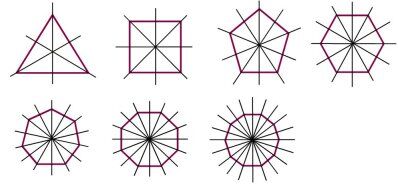Constructing regular polygons requires a ruler, a protractor, and/or a compass. In addition, the various methods proposed below require a good understanding of the concepts of interior angle and central angle.
There are different ways to draw a regular polygon depending on the property referred to.
This method makes it possible to construct a regular polygon when the side measurements are not specified. Follow these steps to use this method.
-
Draw a point in the centre of a circle. Open a compass and place the compass tip on that point. Use the compass to draw a circle, making sure to keep the same opening. Tip: The larger the compass opening, the larger the regular polygon.
-
With a ruler, draw a radius connecting a point on the circle to its centre.
-
Using the central angle formula, calculate the measurement of each angle at the centre of the regular polygon.
-
Use a protractor and the circle’s radius to draw an angle in the centre whose measurement is equivalent to the one calculated in step 3. Extend the line to obtain another radius.
-
Repeat step 4, making sure to proceed from one adjacent angle to another moving clockwise or counterclockwise.
-
Complete the regular polygon by using a ruler to connect the intersections where each radius meets the circle.
This procedure can be used to construct almost any type of regular polygon.
Construct a regular pentagon using a ruler and compass.
|
|
|
|
|
|
The following method can be used to construct a regular polygon when the measurements of its sides are known. To do so, follow these steps.
-
Using a ruler, draw a line segment whose length corresponds to the measurement of the regular polygon’s side.
-
Find the measurement of the desired interior angles using the formula for calculating the interior angle of a regular polygon.
-
Using a protractor, construct an angle at one end of the line segment that is equivalent to the measurement of the interior angle.
-
Respecting the angle constructed in step 3, draw another line segment whose length is equivalent to the polygon’s side measurement.
-
At the end of this line segment, use a protractor to construct another angle equivalent to the first one. Then, draw another line segment to form the next side of the regular polygon.
-
Repeat step 5 until the regular polygon is closed and completed.
Only a ruler and protractor are needed to construct this polygon.
Follow these steps to construct a regular hexagon whose sides measure |3\ \text{cm}|.
|
|
|
|
|
|
An axis of symmetry is a line that cuts a figure into two equal parts. Each part overlaps perfectly when the figure is folded along the axis of symmetry.
In regular polygons, there are as many axes of symmetry as there are sides. Thus, a triangle has 3 axes of symmetry while an octagon has 8.
Here are the axes of symmetry of the main regular polygons.

To construct axes of symmetry in a regular polygon, it is important to consider the number of sides as this will provide the number of axes of symmetry it contains. The best method for constructing the axes of symmetry will differ depending on whether the regular polygon has an even or an odd number of sides.
If the regular polygon has an even number of sides (|4, 6, 8, 10...|) there will be an axis of symmetry for each pair of opposite sides. In addition, there will be an axis of symmetry connecting each pair of opposite vertices.
It is necessary to use a ruler when drawing the axes of symmetry.
Draw the axes of symmetry of a regular hexagon whose sides measure |4\ \text{cm}.|
|
|
|
|
If the regular polygon has an odd number of sides (|3, 5, 7, 9...|), there will be an axis of symmetry from each vertex connecting to the midpoint of the opposite side.
Use a ruler when drawing the axes of symmetry.
Draw the axes of symmetry of a regular pentagon whose sides measure |4\ \text{cm}.|
|
|
|
|